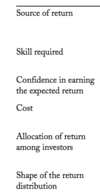Week 5 Flashcards
(130 cards)
all of the available asset allocation approaches that can be employed to assist the asset allocation decision
A
Mean-variance analysis
B
Liability-driven investing (e.g. DB funds)
C
Benchmark-related
D
Fundamental risk approach
E
Two-stage approach
F
Scenario analysis
G
Dynamic strategies
H
Fill the buckets
Is the amount of “liability” in a DB fund totally determined by the portfolio manager or the board?
liability is not a choice. can be determined by some extent e.g. close DB fund to future new employees
the liability in a DB fund is an
actuarial estimate of the present value of future retirement benefits payable to members.
Is the “liability” driven by discount rate applied to projected benefits?
valuation of projected liabiiities rely on numerator (salary growth, longevity of employees)
denominator the discount rate
Why is the “liability” viewed as a negative asset (holding this asset results in paying out cash flows).
negative cash flows in the future
distinguish between DB fund managers and active equity managers?
db funds have their own characteristics/projected liabilites to meet, no benchmark performance
active australian equity managers given ASX 200 and ASX 100 benchmark as performance target
should all DB funds choose the minimum risk portfolio?
NO, minimum risk portfolio in DB funds is the portfolio or asset allocation that will provide perfect match between the assets and projected liabiltes
each db funds has its own board to go through negotaition process with sponsoring entity. opinion of representative from union of employees. use best match of assets and liabilites as a STARTING POINT then come up with asset allocation process
The asset allocation of DB funds is the outcome that
that balances the objectives of all stakeholders, i.e. sponsoring entity, members, government, portfolio manager, etc.
Mean-variance optimization can be applied to a DB fund asset alloction analysis if
the projected liability can be characterized and included as a negative asset in its total portfolio. This analysis helps to understand how the liability contributes to the total portfoio risk and return (its covariance with all the other assets in the portfolio).
helps portfolio manager to understand the projected liability to the total portfolio risk and return.
Fundamental risk approach may improve the risk-return tradeoff of portfolios by
switching to assets of similar expected return and lower standard deviations
apply on top of quantitiative asset allocation output to improve economic exposure
Fundamental risk approach (mostly qualitative) may be applied in
addition to a quantitative asset allocation approach, eg. mean-variance optimization, to improve the diversification of the protfolio marginally.
List methods of forecasting the ER of a group of assets
- implied view method
- black-litterman approach that combines market equilibrium and investors expectation
- Bayesian technique, for instance, James Stein estimator
Confidence interval around per-annum ER
usually narrows with investment horizon
wealth is
accumulation of return over multiple periods.
confidence interval around wealth
may increase or decrease with investment horizon given long term view and returns are not serially correlated
depends how ER returns are positive or negative.
variance is a
linear function of time only if returns and independently and individually distributed.
risk as measured by a shortfall constraint
depends on the mean and variance of means
shortfall constraint = probability of loss
method most likely to be an error maximiser/ generate an error maximiser/generate errors because of the errors in the inputs i.e. STD and ER
i.e. generate portfolios than remain largely a reflection of any errors or inconsistencies in the inputs
mean-variance optimisation based on historical inputs with asset weighting constraints imposed e.g. 20%
higher risk of errors in input. these will fit into mean-variance optimsisation –> mean variance optimisation = error maximiser
which of the following optimisation methods is most likely to generate portfolios than remain largely a reflection of any errors or inconsistencies in the inputs?
what are the inputs
STD and ER in mean variance optimisation model.
mean-variance optimisation with an additional constraint in benchmark risk i.e. tracking error versus the peer benchmark
why does this not make the mean-variance optimisatoin an error maximiser
even though you are using historical inputs, tracking error in place, more likely to generate something meaningful.
In instances where the expected returns do not seem reasonable, how might you respond in order to establish a more reasonable basis for analysis? (Implied views method)
option 6
Use another return modeling approach
In instances where the expected returns do not seem reasonable, how might you respond in order to establish a more reasonable basis for analysis? (Implied views method)
option 5
Adjust inputs towards something considered to be more reasonable
(Note: This probably needs to be done within a parametric approach, so that E[R]s and covariances (or standard deviation and correlation) are all adjusted towards their “underlying” levels, e.g. push up both E[R] and beta on DP. Under the non-parametric, data-based approach, only the mean and hence E[R] can be readily adjusted.)
In instances where the expected returns do not seem reasonable, how might you respond in order to establish a more reasonable basis for analysis? (Implied views method)
option 4
Possibly change the reference portfolio. (Note: This may be problematic. The reference portfolio has probably been selected for a specific reason, such as representing the peer group, etc. Also you should ideally use the reference portfolio relative to which assets are priced in the market, in the spirit of the CAPM. However, the identity of this portfolio is quite unclear
In instances where the expected returns do not seem reasonable, how might you respond in order to establish a more reasonable basis for analysis?
option 2
Try a different estimation interval (e.g. yearly data) or time periods, and see if estimates improve












